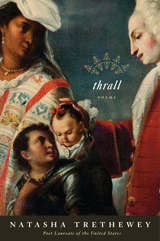Thrall, the latest collection by U.S. Poet Laureate Natasha Trethewey, is at once a universal as well as a deeply personal book, exploring the impact of race on our national identity through the lens of one woman’s experience. Its opening poem, “Elegy,” sets the tone:
. . . I can tell you now
that I tried to take it all in, record it
for an elegy I’d write—one day—
when the time came. Your daughter,
I was that ruthless. What does it matter
if I tell you I learned to be? . . .
Trethewey states the poem is “for my father” and the collection is “to my father”—her father being poet and Hollins University professor Eric Trethewey, a white man. He and her mother, Gwendolyn Ann Turnbough, who was black, were illegally married at the time of Trethewey’s birth in 1966 Mississippi. They divorced when she was six. When Trethewey was nineteen, her mother was killed by her second husband, whom she had also divorced.
Though readers are often cautioned not to assume a poet’s biography figures into her poems, this collection is steeped in Natasha Trethewey’s own history, as well as the history of all people of mixed racial lineage. She takes the reader on a journey through time via ekphrastic poems on paintings dating back to the mid-fourteenth century—works of art that depict relationships between the races, the first example being the numerous portrayals of saints Cosmas and Damian grafting the leg of a dead, black slave onto the body of an ailing white recipient in an attempt to save his life: “How not to see it— / the men bound one to the other, symbiotic— / one man rendered expendable, the other worthy / of this sacrifice?”
Trethewey examines casta paintings from 1715, which attempted to delineate a taxonomy of mixed-racial identity: “mestiso,” “mulato,” “castiza,” “torna atrás.” We sense her deducing her own position on the scale when she notes “The boy is a palimpsest of paint— / layers of color, history rendering him // that precise shade of in-between.” In “Mano Prieta,” Trethewey describes a photograph of her own family when she was just three years old as if it was one of these paintings, noticing how her white father sits on a chair, “a throne,” in the center, with herself “propped / against his knees” and her mother perched on an arm of the chair; her mother’s black finger pressed against Trethewey’s arm “makes visible a hypothesis of blood, / its empire of words.” Trethewey’s family becomes a metaphor for what could be construed as the American caste system, in which white people, particularly white men, dominate socially and economically over people of color. Under the theory depicted by the casta paintings, even those white-skinned descendants of mixed-racial lineages, several generations removed from their supposedly "tainted" ancestor, still carry a “dark spot,” a mark of inferiority. We feel Trethewey’s pain when her father utters the words “I study / my crossbreed child,” yet we learn through her exploration of her own place in history how it is that they—and all of us—are intertwined, how “the past holds us captive.”
It is fair and accurate to describe Natasha Trethewey as a Southern poet. She continues to serve as poet laureate of Mississippi and she is the Robert W. Woodruff Professor of English and Creative Writing at Emory University in Atlanta, where she is also director of the Creative Writing Program. To say she is only a Southern poet, however, or to say that issues of racial identity are only Southern issues would be understating both the significance of Trethewey’s work and the implications of racial inequality throughout the United States. According to a recent article in The New York Times, the average three-member black household earns only 59 percent of what the equivalent white household makes; black men are six times as likely as white men to be incarcerated; and 80 percent of all Americans say more work needs to be done toward achieving racial equality. The genius of Trethewey’s poems is that they make the political personal and that they do it in a way that is accessible to every reader, Northern or Southern, from the east coast to the west. Thrall pushes us to reach back across our ancestry to discern the origin of racial discrimination not only in the U.S., but throughout all of humanity.
These are poems that can challenge scholars while being remarkably easy to read. Trethewey is highly skilled, but not trying to show off. She uses simple, straightforward language. Her poems are structured but none becomes a maze. With the collection in Thrall, Natasha Trethewey has laid a bridge that she invites one and all to cross, holding onto her hand. For some, the trip may be rough—“I was that ruthless”—but it is a journey we must not avoid.
* * *
Karen Pickell is associate editor of Flycatcher.
